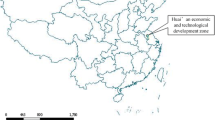Abstract
A method is proposed to calculate the chemical exergy with allowance for the chemical composition and the ambient temperature. The exergy analysis of cement clinker burning is performed. It is found that the maximal energy saving for a rotary cement kiln can be achieved by decreasing the sludge humidity and optimizing the fuel combustion and the clinker cooler operation. The analysis of thermal processes in terms of exergy characteristics is demonstrated to be more efficient than that in terms of thermal parameters, since the optimization and intensification of industrial kilns requires not only heat loss reduction but also more efficient use of heat.
Similar content being viewed by others
Abbreviations
- A, B, C:
-
chemical elements in the composition of a chemical compound
- a, b, c :
-
stoichiometric coefficients of the elements A, B, and C, respectively
- a 0, a 1, a 2 :
-
coefficients of equations for the chemical exergies of elements or compounds
- c p :
-
true molar specific heat at constant pressure, kJ/(mol K)
- e:
-
thermomechanical exergy of a substance in a flow, kJ/mol
- e A, e B, e C :
-
molar exergies of the chemical elements A, B, and C, respectively, kJ/mol
- e ch :
-
chemical exergy of elements or compounds, kJ/kg
- e ep :
-
exergy of the electric power, kJ/kg
- e f :
-
exergy of the fuel, kJ/mol
- e in :
-
exergy of the inlet flows, kJ/kg
- ek :
-
chemical exergy of the kth element, kJ/kg
- e np :
-
exergy of the non-power-generating raw material fed to the kiln, kJ/kg
- e out :
-
exergy of the outlet flows, kJ/kg
- e p :
-
useful exergy of the product, kJ/mol
- e r :
-
molar reaction exergy of compounds, kJ/mol
- G f :
-
equivalent fuel consumption per ton of clinker, kg
- H, H 0 :
-
enthalpies at the temperatures T and T 0, respectively, kJ/mol
- K:
-
optimization criterion
- m ik :
-
stoichiometric coefficient of the kth element in the ith substance (in the absence of the element, m ik = 0)
- N:
-
number of chemical elements or reference substances
- p i :
-
nonnegative weighting coefficient for the ith compound
- p 0 :
-
ambient pressure, Pa
- R:
-
number of compounds in a database
- S, S 0 :
-
entropies at the temperatures T and T 0, respectively, kJ/(mol K)
- t:
-
temperature, °C
- T:
-
temperature, K
- t 0 :
-
ambient temperature, °C
- T 0 :
-
ambient temperature, K
- x i :
-
concentration of the ith substance in the atmosphere
- Δe :
-
exergy loss, kJ/kg
- ΔG :
-
Gibbs energy of a chemical compound, kJ/mol
- ΔG i :
-
Gibbs energy of the ith reference substance at a given ambient temperature, kJ/mol
- ΔS :
-
entropy change, kJ/(kg K)
- ηe :
-
exergy efficiency characterizing the exergy loss
- ηh :
-
thermal efficiency
- ηk :
-
exergy efficiency of kilns
- ηt :
-
technological efficiency
References
Szargut, J. and Petela, R., Egzergia, Warszawa: Wysdawnictwa Naukowo-Techniczne, 1965. Translated under the title Eksergiya, Moscow: Energiya, 1968.
Brodyanskii, V.M., Fratsher, V.K., and Mikhalek, K., Eksergeticheskii metod i ego primenenie (Exergy Method and Its Application), Moscow: Energoatomizdat, 1988.
Sazhin, B.S., Bulekov, A.P., and Sazhin, V.B., Eksergeticheskii analiz raboty promyshlennykh ustanovok (Exergy Analysis of Operation of Industrial Plants), Moscow: Kosygin Mosk. Gos. Tekstil. Univ., 2000.
Kafarov, V.V., Printsipy sozdaniya bezotkhodnykh khimicheskikh proizvodstv (Principles of Engineering of Wasteless Industrial Chemical Processes), Moscow: Khimiya, 1982.
Brodyanskii, V.M., Verkhivner, G.P., Karchev, Ya.Ya., et al., Eksergeticheskie raschety tekhnicheskikh sistem (Exergy Calculations of Technical System), Kiev: Naukova Dumka, 1991.
Besedin, P.V. and Trubaev, P.A., Thermodynamic Database for Analyzing the Processes of Production of Silicate Building Materials: Part 1, Vestn. Belgorod. Gos. Tekhnol. Univ., 2003, no. 5, pp. 229–233.
Kireev, V.A., Metody prakticheskikh raschetov v termodinamike khimicheskikh reaktsii (Methods of Applied Calculations in Thermodynamics of Chemical Reactions), Moscow: Khimiya, 1975.
Trubaev, P.A. and Per’kov, S.A., Intensification of Clinker Burning by Introducing Technogenic Products into the Kiln, Sb. dokl. Mezhdunar. nauchno-praktich. konf. “Sovremennye tekhnologii v promyshlennosti stroitel’nykh materialov i stroiindustrii” (Proc. Int. Scientific and Practical Conf. on Modern Belgo Technologies in the Building Materials Industry and the Construction Industry), Belgorod: Shukhov Belgorod Gos. Tekhnol. Univ., 2003, part 1, pp. 111–115.
Author information
Authors and Affiliations
Additional information
Original Russian Text © P.A. Trubaev, 2006, published in Teoreticheskie Osnovy Khimicheskoi Tekhnologii, 2006, Vol. 40, No. 2, pp. 191–198.
Rights and permissions
About this article
Cite this article
Trubaev, P.A. Exergy analysis of thermal processes in the building materials industry. Theor Found Chem Eng 40, 175–182 (2006). https://doi.org/10.1134/S0040579506020102
Received:
Issue Date:
DOI: https://doi.org/10.1134/S0040579506020102




